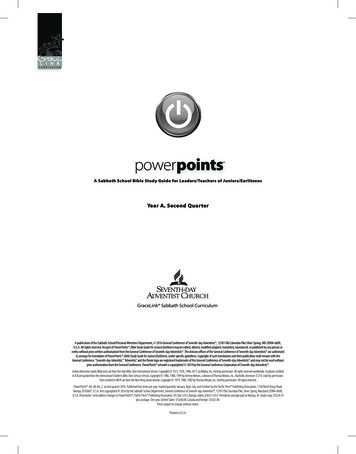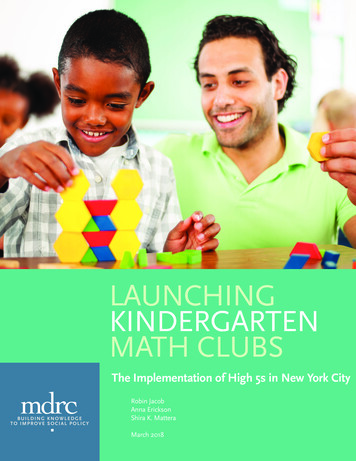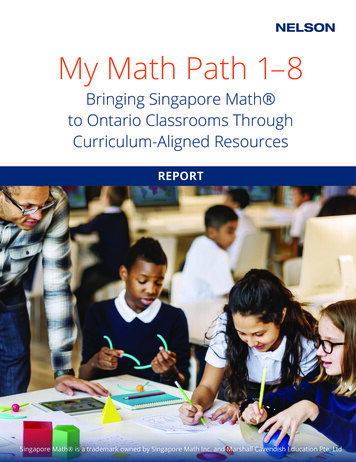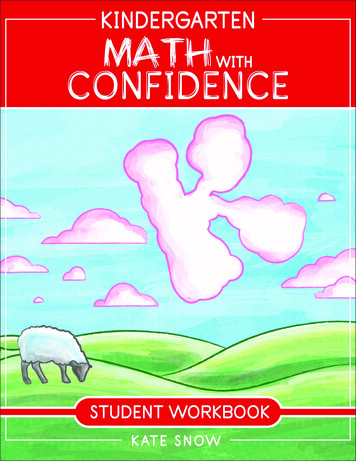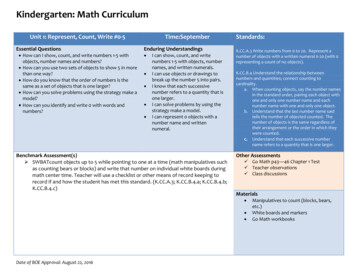
Transcription
Kindergarten: Math CurriculumUnit 1: Represent, Count, Write #0-5Essential Questions How can I show, count, and write numbers 1-5 withobjects, number names and numbers? How can you use two sets of objects to show 5 in morethan one way? How do you know that the order of numbers is thesame as a set of objects that is one larger? How can you solve problems using the strategy make amodel? How can you identify and write 0 with words andnumbers?Time:SeptemberEnduring Understandings I can show, count, and writenumbers 1-5 with objects, numbernames, and written numerals.I can use objects or drawings tobreak up the number 5 into pairs.I know that each successivenumber refers to a quantity that isone larger.I can solve problems by using thestrategy make a model.I can represent 0 objects with anumber name and writtennumeral.Benchmark Assessment(s) SWBATcount objects up to 5 while pointing to one at a time (math manipulatives suchas counting bears or blocks) and write that number on individual white boards duringmath center time. Teacher will use a checklist or other means of record keeping torecord if and how the student has met this standard. (K.CC.A.3; K.CC.B.4.a; K.CC.B.4.b;K.CC.B.4.c)Standards:K.CC.A.3 Write numbers from 0 to 20. Represent anumber of objects with a written numeral 0-20 (with 0representing a count of no objects).K.CC.B.4 Understand the relationship betweennumbers and quantities; connect counting tocardinality.a. When counting objects, say the number namesin the standard order, pairing each object withone and only one number name and eachnumber name with one and only one object.b. Understand that the last number name saidtells the number of objected counted. Thenumber of objects is the same regardless oftheir arrangement or the order in which theywere counted.c. Understand that each successive numbername refers to a quantity that is one larger.Other Assessments Go Math p43—46 Chapter 1 Test Teacher observations Class discussionsMaterials Date of BOE Approval: August 22, 2016Manipulatives to count (blocks, bears,etc.)White boards and markersGo Math workbooks
Kindergarten: Math CurriculumSUGGESTED ACTIVITIES Go Math! Interactive Student Edition videosGo Math! Personal Math TrainerGo Math! On the Spot videosComplete Number of the Day question (Teacher manual p61B)Review vocabulary few, more, zeroGrab and Go ActivitiesComplete Fluency Builder with numeral cards 1-5 (Teacher manual p61B)Math Center 5 frames: Students pull a number card, read that number, then place that amountof counters on their 5 frameCreate a Number Storybook for numbers 1-5 (See Go Math Manual p8B)Sing songs about numbers from Dr. Jean’s Totally Math CDBuild cube towers using snapcubes based on a given numberPlay Bus Stop game where students roll a number cube and move that many spaces (See GoMath Teacher Manual p12)Have students go on a number hunt around the school searching number words and numerals.Count the days of school and represent them with objects such as straws, pennies, ten frames,base ten blocks. Etc.Write numbers on ipad using HWT app Date of BOE Approval: August 22, 2016REINFORCEMENTUse Reteach page 1.1-1.10Work one-on-one with studentProvide a number line for the desk or forthe floorProvide manipulativesHave the student continue to work onnumbers 1 and 2 before moving onHave student use playdoh or sand to formthe numbersENRICHMENTUse 10 frames for students that are readyto move beyond numbers 0-5.Use Enrichment page 1.1-1.10Model how to draw a simple scene thatshows sets of one and two objects. Labelthe picture 1 and 2 (or more). Studentsdraw and label their own pictures andhave partners find examples of one andtwo in each other’s drawings
Kindergarten: Math CurriculumSuggested Websites mathhttp://www.abcya.com/kindergarten ww.education.com/games/Suggested Materials Cross-Curricular ConnectionsTechnology8.1.2.E.1 Use digital tools and online resources to explore a problem or issue.Date of BOE Approval: August 22, 20165 frames and countersNumber linesNumber CardsVocabulary CardsVariety of manipulativesPlay doh or sand for writing numbersGrab-and-Go Kits: ActivitiesSmartboard/Mimio/ipadsPancakes for All(GoMath!)The Red Caboose(GoMath!)Quack and Count5 Little DucksHow Dinosaurs Count to 10DoggiesMouse Count1, 2, 3 to the Zoo10 Red Apples by Pat HutchinsOne Fish, Two Fish, Red Fish, Blue FishChicka Chicka 1, 2, 3Pete the Cat and His Four Groovy ButtonsEach Orange Had 8 slicesBears on Wheels
Kindergarten: Math CurriculumUnit 2: Compare Numbers to 5Essential Questions How can building and comparing sets help youcompare numbers?Time: September-OctoberEnduring Understandings I can use matching and countingstrategies to compare sets.I know when one set is the same, greaterthan, or less than another set.Benchmark Assessment(s) SWBAT use matching and counting strategies to compare sets on Chapter 2 Test p15-18.Teacher will observe students during test and score afterwards. Students that score 7/10or more display an understanding of the content for this standard. (K.CC.C.6)Standards:K.CC.C.6 Identify whether the number ofobjects in one group is greater than, less than,or equal to the number of objects in anothergroup, e.g., by using matching and countingstrategies.Other Assessments Teacher observations Lesson workbook pages Show What You Know assessment(Background knowledge assessmentfrom GoMath!) Personal Math Trainer questions andstudents answer on white boardsMaterials Date of BOE Approval: August 22, 2016Chapter 2 Test page 14-18CountersSnapcubes5 frames or 10 frames
Kindergarten: Math CurriculumSUGGESTED ACTIVITIES Go Math! Interactive Student Edition videosGo Math! Personal Math TrainerGo Math! On the Spot videosComplete Number of the Day questionReview vocabularyGrab and Go ActivitiesComplete Fluency BuilderPlay Counting to Blastoff Game (GoMath)Play Bingo Game (GoMath)Have students place snapcubes on objects, then stack the snapcubes tocompare the two sets.Have students roll the die, then build a tower with that many blocks, andrepeat. Then students push the two towers together and compare.Suggested Websites mathhttp://www.abcya.com/kindergarten es/ REINFORCEMENTReteach pages 2.1-2.5Have students write down the number in each set beforecomparing.Have students use pipecleaners or other objects to matchthe objects in the sets as a better visual.Have students use two separate colors for each set todiscriminate between the sets.ENRICHMENTEnrich pages 2.1-2.5Have students use larger sets to compare.Have students try to do the matching strategy withoutmanipulatives (just visually comparing objects)Suggested Materials Vocabulary CardsNumber cardsManipulativesSmartboard/Mimio/ipadsMabel’s Place (GoMath!)Quack and Count5 Little DucksHow Dinosaurs Count to 10DoggiesMouse Count1, 2, 3 to the Zoo10 Red Apples by Pat HutchinsOne Fish, Two Fish, Red Fish, Blue FishChicka Chicka 1, 2, 3Pete the Cat and His Four Groovy ButtonsCross-Curricular ConnectionsTechnology:8.1.2.A.4. Demonstrate developmentally appropriate navigation skills in virtual environments (i.e. games, museums).Date of BOE Approval: August 22, 2016
Kindergarten: Math CurriculumUnit 3: Represent, Count, WriteNumbers 6-9Essential Questions How can you show, count, and write numbers6-9? How can you solve problems using thestrategy draw a picture?Time: OctoberEnduring Understandings I can show, count, and write numbers 6-9.I can solve problems by using the strategydraw a picture.Standards:K.CC.A.3 Write numbers from 0 to 20. Representa number of objects with a written numeral 0-20(with 0 representing a count of no objects).K.CC.B.5 Count to answer “how many?” questionsabout as many as 20 things arranged in a line, arectangular array, or a circle, or as many as 10things in a scattered configuration; given anumber from 1-20, count out that many objects.K.CC.C.6 Identify whether the number of objectsin one group is greater than, less than, or equal tothe number of objects in another group, e.g., byusing matching and counting strategies.Benchmark Assessment(s) SWBAT count objects up to 9 while pointing to one at a time (math manipulatives suchas counting bears or blocks) and write that number on individual white boards duringmath center time. Teacher will use a checklist or other means of record keeping torecord if and how the student has met this standard. (K.CC.A.3; K.CC.B.5)Other Assessments Show What You Know assessment(Background knowledge assessment fromGoMath!) Mid Chapter Checkpoint (GoMath!) Teacher observations Class discussions Math Center WorkMaterials Date of BOE Approval: August 22, 2016Manipulatives to count (blocks, bears,etc.)White boards and markersGo Math workbooks
Kindergarten: Math CurriculumSUGGESTED ACTIVITIES Go Math! Interactive Student Edition videosGo Math! Personal Math TrainerGo Math! On the Spot videosComplete Number of the Day questionGrab and Go Activities: Eight and Nine are Fine!Seeing EightAt 6s and 7sSuper 6Review vocabularyComplete Fluency Builder Review the days of the week with children pointing to each day andcount the number of days in a week, then provide questions for students about the calendarPlay Number Line Up Game (GoMath! P118)Partners collect objects from nature outside to show sets of a given number. Students thenwrite that number on an index card. Sets can be displayed as a museum.Children use six cubes to build a cube train then students add one more cube to the train andverify the number of cubes. Repeat using a spinner to determine the starting number of cubes.Ask students to add more cubes to the cube train to make 7.Tell children about spiders (8 legs in pairs, eyes, spin silk, etc.) and have them draw one basedon your oral description.Write numbers on ipad using HWT appPlay Chutes and Ladders, Trouble, Sorry, or Candyland in as math center Date of BOE Approval: August 22, 2016REINFORCEMENTUse Reteach page 3.1-3.9Work one-on-one with studentProvide a number line for the desk or forthe floorProvide manipulativesHave the student continue to work onnumbers 6 and 7 before moving onHave student use playdoh, shavingcream, or sand to form the numbersENRICHMENTUse 10 frames for students that are readyto move beyond numbers 6-9.Use Enrichment page 3.1-3.9Have children color in squares on gridpaper to make different shapes. Eachshape should contain six squares.Encourage children to make as manydifferent shapes as possible. Have themdiscuss their shapes with partnersHave the child count out and link eightcubes to form a cube train, then break itinto 2 parts that have the same numberof cubes. Pose questions throughout.Have the student shake and toss ninecounters froma bag and put red countersin one set and yellow in another. Askquestions about counters. Child thendraws the combination and writes howmany of each color and how many in all.Repeat to show as many differentcombinations s/he can make for 9.
Kindergarten: Math CurriculumSuggested Websites mathhttp://www.abcya.com/kindergarten ww.education.com/games/Suggested Materials Cross-Curricular ConnectionsN/ADate of BOE Approval: August 22, 2016ManipulativesBoard GamesNumber CardsSmartboard/Mimio/ipadsQuack and CountChicka Chicka 1, 2, 3Anno’s Counting Book10 Apples Up on TopCounting CrocodilesQuack and Count5 Little DucksHow Dinosaurs Count to 10DoggiesMouse Count1, 2, 3 to the Zoo10 Red Apples by Pat HutchinsOne Fish, Two Fish, Red Fish, Blue FishChicka Chicka 1, 2, 3Pete the Cat and His Four Groovy ButtonsMabel’s Place (GoMath!)A Nutty Story (GoMath!)
Kindergarten: Math CurriculumUnit 4: Represent and Compare #s to 10Essential Questions How can you show and count 10 objects? How can you write up to 10 with words and numbers? How can you use a drawings and count to 10 from agiven number? How can you solve problems using the strategy make amodel? How can you compare sets of objects using countingstrategies?Time: NovemberEnduring Understandings I can model and count 10 withobjects.I can show up to 10 objectswith a number name andnumber.I can use a drawing to make10 from a given number.I can count forward fromagiven number.I can use counting strategiesto compare sets of objects.Standards:K.CC.A.2 Count forward beginning from a given numberwithin the known sequence (instead of having to begin at1).K.CC.A.3 Write numbers from 0 to 20. Represent a numberof objects with a written numeral 0-20 (with 0representing a count of no objects).K.CC.B.5 Count to answer “how many?” questions aboutas many as 20 things arranged in a line, a rectangular array,or a circle, or as many as 10 things in a scatteredconfiguration; given a number from 1-20, count out thatmany objects.K.CC.C.6 Identify whether the number of objects in onegroup is greater than, less than, or equal to the number ofobjects in another group, e.g., by using matching andcounting strategies.K.CC.C.7 Compare two numbers between 1 and 10presented as written numerals.K.OA.A.4 For any number from 1 to 9, find the number thatmakes 10 when added to the given number, e.g., by usingobjects or drawings, and record the answer with a drawingor equation.Benchmark Assessment(s) SWBAT count objects up to 10 while pointing to one at a time (math manipulatives such ascounting bears or blocks) and write that number on individual white boards during mathcenter time. Teacher will use a checklist or other means of record keeping to record if andhow the student has met this standard. (K.CC.A.3; K.CC.B.5) SWBAT count from a given number. During math centers, teacher can ask student to countfrom a given number. Teacher will use a checklist or other means of record keeping torecord if and how the student has met this standard. (K.CC.A.3) SWBAT compare two written numbers on workbook p218-219 and circle the number that ismore on page 218 and less on page 219. Collect for student portfolios and score. Studentsthat score 8/10 demonstrate an understanding of this standard. (K.CC.C7)Date of BOE Approval: August 22, 2016Other AssessmentsShow What You Know assessmentMid Chapter Checkpoint (GoMath!)Teacher observationsStudents workbookClass discussions Math Center work Materials Manipulatives (blocks, counting bears)Student workbooks
Kindergarten: Math CurriculumSUGGESTED ACTIVITIES Go Math! Interactive Student Edition videosGo Math! Personal Math TrainerGo Math! On the Spot videosComplete Number of the Day questionReview vocabularyGrab-and-Go activity:17 RoundupComplete Fluency BuilderPlay Memory game with math words (p180 Go Math!)On the Smartboard, or using objects, have two dice for students to roll, record that number,and identify the number that is greater than or less than.Explain that many animals living in or near the ocean have 10 legs. Some of these animals arecrabs, lobsters, and shrimp. Have children draw a picture of one of thse animals and write 10near the legs to show how many.Tell children that many people make “Top Ten Lists”. Give examples and have students workin small groups to create a Top 10 class list.Play Top-It (War)Have students make and play memory cards by writing numbers 0-10 on index cards anddraw pictures 0r cut out magazine pictures of objects and glue on one card, 1 object onanother card, 2 object on another, etc. Then play memory with cards.Read aloud 10 Apples Up on Top and then have students glue apples in order on top of theircut out picture of their face.In a center, have students choose a number card from a face down pile. Then all otherchildren write that number on the white boards to practice number formation and then fill intheir 10 frame with that amount of counters. Rotate around the table.In a center, have students choose a number and have all other children build a block towerwith that many blocks.Date of BOE Approval: August 22, 2016 REINFORCEMENTReteach pages 4.1-4.7Use hand-over-hand to practice countingusing one-to-one correspondence.Provide a number line for the desk or for thefloorProvide manipulativesHave the student continue to work onnumbers 1-9 before moving onHave student use playdoh, shaving cream, orsand to form the numbersENRICHMENTEnrich pages 4.1-4.7Children take turns tossing a number cube,tell the number and say how many moremakes 10. One child models the number pairwith red and yellow counters and the otherchild writes the two numbers. Then switchroles.Distribute 10 post it notes to each child. Havechildren write the numbers 1-10 on them. Askchildren to place the notes in counting oreron a sheet of paper, then have studentscompare the placement of the post-its.Make a number target for each group andtape it to the floor. Invite one groupmember to toss two bean bags into thetarget and call out the numbers whitle theother members show the numbers withcounters. Children tell which number isgreater and less. Switch roles and repeat
Kindergarten: Math CurriculumSuggested Websites mathhttp://www.abcya.com/kindergarten ww.education.com/games/Suggested Materials White boardsNumber linesNumber cardsBlocks10 frames and countersSmartboard/Mimio/ipadI Know Numbers (Go Math!)Raccoon’s Playtime (Go Math!)Quack and Count5 Little DucksHow Dinosaurs Count to 10DoggiesMouse Count1, 2, 3 to the Zoo10 Red Apples by Pat HutchinsOne Fish, Two Fish, Red Fish, Blue FishChicka Chicka 1, 2, 3Pete the Cat and His Four Groovy Buttons10 Little FishCross-Curricular Connections21st Century Skills: CRP8. Utilize critical thinking to make sense of problems and persevere in solving them.Technology: 8.1.2.A.4. Demonstrate developmentally appropriate navigation skills in virtual environments (i.e. games, museums).Date of BOE Approval: August 22, 2016
Kindergarten: Math CurriculumUnit 5:AdditionEssential Questions How can you show addition using numbers 010? How can I solve addition math stories? How can I find different ways to make thesame number?Time: DecemberEnduring Understandings I can put things together and write downthe numbers (0-10) I put together. I can solve addition problems withnumbers 0-10 by acting out. I can use objects and drawings to solveaddition problems (with #s 0-10) and writethe number sentence. I can use a drawing to find 10 from a givennumber and write the number sentence. I can add number pairs and write thenumber sentence. (Example: 5 4 1; 5 2 3;5 0 5))Standards:K.OA.A.1 Represent addition and subtraction up to 10with objects, fingers, mental images, drawings2,sounds (e.g., claps), acting out situations, verbalexplanations, expressions, or equations.K.OA.A.2 Solve addition and subtraction wordproblems, and add and subtract within 10, e.g., by usingobjects or drawings to represent the problem.K.OA.A.3 Decompose numbers less than or equal to 10into pairs in more than one way, e.g., by using objectsor drawings, and record each decomposition by adrawing or equation (e.g., 5 2 3 and 5 4 1).K.OA.A.4 For any number from 1 to 9, find the numberthat makes 10 when added to the given number, e.g., byusing objects or drawings, and record the answer with adrawing or equation.K.OA.A.5 Demonstrate fluency for addition andsubtraction within 5.Benchmark Assessment(s) SWBAT use beads to show 10 in 3 different ways and record addition sentences. Students willneed a pipe cleaner with 10 beads on it with connected ends like a bracelet. In a math center,the teacher will work with a small group and ask them to divide the beads on the bracelet toeach side, and write those two numbers in a number sentence such as 5 5 10. The teacher willthen ask the students to do the same task with different amounts of beads 2 more times sothat the student has 3 number sentences with the sum of 10 on their paper. Then tell studentsa number story such as (Three children sat at the table for lunch. Two more students sat downnext to them. How many children are eating their lunches at the table altogether?) Encouragestudents to use drawings to help write their number sentence. Observe students working andcollect papers for data. (K.OA.A.1; K.OA.A.2; K.OA.A.3; K.OA.A.4) SWBAT add using numbers 0-5. Teacher will give students 10 written problems on a worksheetand have them answer the problems using any strategy. Teacher will collect and score theworksheet. Students that score 7/10 have demonstrated mastery of this standard. (K.OA.A.5)Date of BOE Approval: August 22, 2016Other AssessmentsShow What You Know assessmentMid Chapter Checkpoint (GoMath!)Teacher observationsStudents workbook pagesClass discussions Math Center work Materials Beads, pipecleanersWhiteboards and markers or paperStudent workbooksManipulatives (counting bears, blocks,counters, etc.)Addition assessment with 10 equations
Kindergarten: Math CurriculumSUGGESTED ACTIVITIES Go Math! Interactive Student Edition videosGo Math! Personal Math TrainerGo Math! On the Spot videosComplete Number of the Day questionReview vocabularyComplete Fluency BuilderPlay Go Math! Game Spin to AddGrab and Go activities:Get It Together! Card 6Students can make a paper chain using two different colors on each end then write the numbersentence for the color used. (Example: 4 green chain links and 3 red chain links would have thenumber sentences 4 3 7)Play “Shake Ten and Spill”. Students put 10 counters in a cup, shake the cup and spill out thecounters. Students show how many of each color by writing the corresponding numbersentence . (Example: If 3 yellow and 7 red spill are shown, the student would write 3 7 10)Make a class Number Story Book by having partners illustrate a number story and write thenumber sentence on the page.Students are given 10 counters, blocks, pennies, etc. Tell students to pick up a few of them, writethat number on the white board, and count how many are left to complete the numbersentence for 10.Use flashcards for partners to practice their math facts to 10Partners are given a cube train of 10. One partner break it into two parts and puts one partbehind his/her back. The other partner needs to write how many blocks are behind the otherstudent’s back using the whiteboard.Using 10 water bottles as pins, students use a ball to roll to knock down pins. Students recordthe number sentence to record how many are knocked down and how many are up. (Example:3 7 10)Give students a numbers within 0-10. Have students put that many counters on a ten frame andcount the spaces needed to fill the 10 frame, and record that number sentence for 10.Make a ladybug craft for students to put some dots on one wing, and other dots on the otherwing, then record the number sentence.Students make a 10 rainbow by painting a rainbow first using 6 colors. Students write thenumbers on the bottom of the colors of the rainbow. Click on link to see the 693994/Date of BOE Approval: August 22, 2016 REINFORCEMENTProvide student with a number line,manipulatives, a paper plate divided intotwo small sections and one large sectionto place the manipulativesHave more able students explain thesame task to the student and helpperhaps different phrasing in a child’slanguage can helpAllow child to observe the teacher andpeers working on the task before s/hebegins.Reteach pages 5.1-5.12ENRICHMENTEnrich pages 5.1-5.12Use numbers 0-20 if the student hasmastered addition with numbers 0-10.Challenge student to complete mathproblems mentally.Have student create number stories forpeers to solve.
Kindergarten: Math CurriculumSuggested Websites mathhttp://www.abcya.com/kindergarten ww.education.com/games/Suggested Materials DominosAddition flashcardsNumber cardsSnapcubesCounters and cupsSmartboard/Mimio/ipadTen framesWater bottles and a ball for bowlingTen Little MonkeysTen Apples on TopTen in BedHershey’s Kisses AdditionMission AdditionAdding Animals (big book)Pancakes for All (Go Math!)Flowers for Flossie (Go Math!)Cross-Curricular Connections21st Century Skills:CRP8. Utilize critical thinking to make sense of problems and persevere in solving them.Technology: 8.1.2.A.4. Demonstrate developmentally appropriate navigation skills in virtual environments (i.e. games, museums).Date of BOE Approval: August 22, 2016
Kindergarten: Math CurriculumUnit 6: SubtractionEssential Questions How can you show subtraction as taking apartusing numbers 0-10? How can I solve subtraction math stories?Time: JanuaryEnduring Understandings I can use objects and drawings to solvesubtraction problems (with #s 0-10) andwrite the number sentence. I can solve subtraction problems withnumbers 0-10 by acting out.Standards:K.OA.A.1 Represent addition and subtraction up to10 with objects, fingers, mental images,drawings2, sounds (e.g., claps), acting outsituations, verbal explanations, expressions, orequations.K.OA.A.2 Solve addition and subtraction wordproblems, and add and subtract within 10, e.g., byusing objects or drawings to represent theproblem.K.OA.A.5 Demonstrate fluency for addition andsubtraction within 5.Benchmark Assessment(s)Other Assessments Show What You Know assessment SWBAT subtract up to 10 with objects/drawings for equation and word stories on(Background knowledge assessment fromChapter 6 Test p19-22. Teacher will observe students during test and score afterwards.GoMath!)Students that score 10/13 or more display an understanding of the content for this Mid Chapter Checkpoint (GoMath!)standard. (K.OA.A.1; K.OA.A.2) Teacher observations SWBAT subtract using numbers 0-5. Teacher will give students 10 written problems on a Students workbook pagesworksheet and have them answer the problems using any strategy. Teacher will collect Class discussionsand score the worksheet. Students that score 7/10 have demonstrated mastery of this Math Center workstandard. (K.OA.A.5)Materials Date of BOE Approval: August 22, 2016Student workbooksManipulatives (counting bears, blocks,counters, etc.)Subtraction assessment with 10 equations
Kindergarten: Math CurriculumSUGGESTED ACTIVITIES Go Math! Interactive Student Edition videosGo Math! Personal Math TrainerGo Math! On the Spot videosComplete Number of the Day questionReview vocabularyGo Math! Games:Picture ItGo for MoreSailboat SubtractionComplete Fluency BuilderGo Math! Grab and Go Activities:Bye Bye!Leftovers!I’m Taken!Add and SubtractStudents play board games such as Shoots and Ladders, Trouble, SorryMake a class Number Story Book by having partners illustrate a number story and write thenumber sentence on the page.Students are given 10 counters, blocks, pennies, etc. Tell students to pick up a few of them,write that number on the white board, and count how many are left to complete the numbersentence for 10.Use flashcards for partners to practice their math facts to 10Partners are given a cube train of 10. One partner break it into two parts and puts one partbehind his/her back. The other partner needs to write how many blocks are behind the otherstudent’s back using the whiteboard.Using 10 water bottles as pins, students use a ball to roll to knock down pins. Students recordthe number sentence to record how many bottles were there in the beginning, how many wereknocked down and how many are left up. (Example: 10-5 5)Students play disappearing cube game. Students start with a 10 cube train, roll a die, andsubtract that amount. If working in partners, students see which partner’s train disappears first,then starts over.Sing Songs such as 5 Little Monkeys Jumping on the Bed, 5 Little Monkeys Swinging from a Tree,6 Little Ducks Went Out One Day, 5 Green and Speckled FrogsDate of BOE Approval: August 22, 2016 REINFORCEMENTReteach pages 6.1-6.7Use a multitude of strategies to subtractusing number lines, number grids,manipulatives, fingers, memorizationwith flashcardsProvide student with a paper platedivided into two small sections and onelarge section to place the manipulativesHave more able students explain thesame task to the student and helpperhaps different phrasing in a child’slanguage can helpAllow child to observe the teacher andpeers working on the task before s/hebegins.ENRICHMENTEnrich pages 6.1-6.7Have partners place 10 (or more if able)counters in a bag, shake it, and dump outthe co
Go Math! Personal Math Trainer Go Math! On the Spot videos Complete Number of the Day question (Teacher manual p61B) Review vocabulary few, more, zero Grab and Go Activities Complete Fluency Builder with numeral cards 1-5 (Teacher manual p61B) Math Center 5





